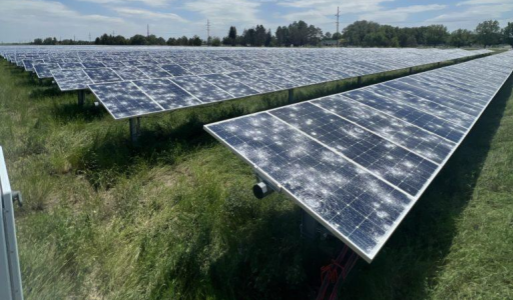Climate change and renewable energy
by Ed Sawicki - May 28, 2024

I was once caught in a hailstorm while driving and pulled to the side of the road next to a tree whose branches softened the blow of the hail pounding my car. I put my seat back and moved my body away from the windows as much as possible. Fortunately, the windows held.

When it was over, I examined the 1 to 2-inch-diameter hail stones. They were solid ice. A Google search showed that the likely speed of these stones was between 40 and 72 miles per hour. More recently, there have been news reports of 4-inch-diameter hail whose terminal velocity is 125 miles per hour. These carry a kinetic energy of 740 Joules. For comparison, a fired 9-millimeter bullet carries about 500 Joules.
We're doing little about climate change and expect severe weather to get worse and more frequent. Our renewable energy resources are vulnerable.
What impact would hail have on solar farms, whose panels are vulnerable? The photo at the top of the page shows the result of a solar farm in Texas after a hail storm.
Here's a video of a large solar farm with hundreds or thousands of panels destroyed by hail.
Here's another video of Texas residents who have contamination concerns after solar panels were damaged.

What about wind turbines? They're vulnerable to severe storms as well. This photo is a turbine whose blades were damaged by extremely high winds during a storm. Other turbines caught fire and collapsed.
What does a power company do when they lose a solar or wind farm? They burn more coal, oil, or gas to make up the difference. That is, if they still have that capacity after switching over to renewables.
What's the solution? What's the best non-polluting energy generation that also far less vulnerable to severe weather?
Nuclear energy, using modern, safe reactors—not the reactors designed decades ago that can threaten us with meltdowns. Modern reactors based on molten salt technology don't melt down. Nuclear reactors also don't put their waste products into the atmosphere as does energy generation based on burning coal, oil, or gas.
One last thing
There's a problem with wind turbines that is not necessarily weather-related. Their blades apparently don't last very long. They're expensive to replace (heavy equipment is required), and they cannot be recycled. Here's a video about ‘Turbine graveyards’ sprawled across Texas
Sources
CBS Colorado: Severe weather brings 4 inch hail, flooding on Colorado's Eastern Plains
Record Setting Hail Event in Vivian, South Dakota on July 23, 2010
What Impact Energy from Hail Stone should Meteorological Instruments be able to Survive?